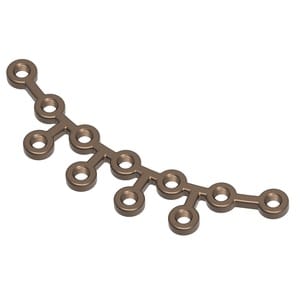Orthopedic implant manufacturers are at the forefront of transforming mobility for patients worldwide. In 2025, advancements in technology, materials, and design are leading to more effective, personalized, and minimally invasive treatments. This article explores how these innovations are enhancing mobility, with a focus on variable angle plates and the role of manufacturers like Ace Osteomedica.
Summary
In 2025, orthopedic implant manufacturers are significantly enhancing mobility through:
- The Manufacturers of variable angle plates that offer customizable screw placement for improved fixation.
- Advancements in 3D printing, smart implants, biodegradable materials, and regenerative medicine.
- The contribution of manufacturers like Ace Osteomedica in providing high-quality orthopedic solutions.
- These innovations are leading to more personalized, effective, and minimally invasive treatments, improving the quality of life for patients worldwide.

Understanding Variable Angle Plates
Variable angle plates are advanced orthopedic implants that allow screws to be inserted at different angles. This flexibility enables surgeons to optimize fixation in challenging fractures, especially in osteoporotic bones.
Benefits of Variable Angle Plates
- Enhanced Fixation in Weak Bones: By allowing screws to be placed in denser bone areas, variable angle plates provide a stronger hold in osteoporotic bones.
- Improved Stability in Complex Fractures: The ability to angle screws in multiple directions enhances stability in multi-fragmentary fractures, reducing the risk of fixation failure.
- Customizable Screw Placement: Surgeons can angle screws to avoid critical structures like nerves and blood vessels, minimizing soft tissue irritation.
These features make variable angle plates a valuable tool in modern orthopedic surgery, contributing to better patient outcomes.
How Are Orthopedic Implant Manufacturers Enhancing Mobility?

3D Printing and Personalized Implants
3D printing technology allows for the creation of highly customized implants that perfectly match a patient’s unique anatomy. This personalized approach offers several advantages:
- Improved Fit: 3D-printed implants can be designed to fit the patient’s specific bone structure, leading to better stability and reduced risk of complications.
- Enhanced Functionality: Implants can be tailored to address specific patient needs, such as optimizing joint biomechanics or accommodating pre-existing conditions.
- Minimally Invasive Surgery: 3D printing can create smaller, more precise implants, enabling less invasive surgical procedures with faster recovery times.
Smart Implants with Embedded Sensors
The integration of smart technology into orthopedic implants is transforming post-operative care. Smart implants can:
- Monitor Implant Performance: Embedded sensors can track implant function, such as wear and tear, loosening, or infection, allowing for early detection of potential problems.
- Provide Real-time Data: Data collected by smart implants can be transmitted wirelessly to healthcare providers, enabling remote monitoring of patient progress.
- Improve Patient Outcomes: Smart implants can help optimize treatment plans and improve long-term outcomes by providing valuable insights into implant behavior and patient recovery.
Read About Diet – What is PCOD and Why Does Diet Matter?
Biodegradable Implants
Traditional orthopedic implants often require a second surgery for removal. Biodegradable implants offer a promising alternative by gradually dissolving or being absorbed by the body over time.
- Tailored Degradation: Biodegradable materials can be engineered to degrade at a specific rate, ensuring they provide support during the necessary healing period.
- Reduced Risk of Complications: By eliminating the need for implant removal, biodegradable implants can reduce the risk of infection and other complications associated with revision surgery.
- Improved Patient Experience: Biodegradable implants can lead to a more streamlined and less invasive treatment experience for patients.
Advanced Materials and Coatings
Ongoing research is focused on developing novel materials and coatings that enhance the performance and longevity of orthopedic implants. These advancements include:
- Stronger, More Durable Materials: New materials like ceramics and polymer composites are being developed to provide greater strength, wear resistance, and biocompatibility.
- Antimicrobial Coatings: Coatings infused with antimicrobial agents can help prevent infection, a major concern with orthopedic implants.
- Bioactive Coatings: Coatings that promote bone growth and integration can enhance implant stability and accelerate healing.
Regenerative Medicine Approaches
Regenerative medicine techniques are being explored to promote natural tissue repair and regeneration around orthopedic implants. These approaches may include:
- Stem Cell Therapy: Using stem cells to stimulate tissue growth and repair damaged bone and cartilage.
- Growth Factor Delivery: Utilizing implants that deliver growth factors to promote healing and tissue regeneration.
- Tissue Engineering: Engineering new tissues and organs to replace damaged ones, offering a potential long-term solution for severe orthopedic conditions.
Role of Ace Osteomedica in Enhancing Mobility
Ace Osteomedica is a leading manufacturer specializing in orthopedic implants, including variable angle plates. Their commitment to quality and innovation ensures that patients receive reliable and effective solutions for enhanced mobility.
FAQs
What are variable angle plates?
Variable angle plates are orthopedic implants that allow screws to be inserted at different angles, providing enhanced fixation in challenging fractures.
How do 3D printing and smart implants enhance mobility?
3D printing allows for personalized implants that fit a patient’s unique anatomy, while smart implants with embedded sensors enable real-time monitoring of implant performance and patient recovery.
What is the role of biodegradable implants in enhancing mobility?
Biodegradable implants gradually dissolve or are absorbed by the body over time, eliminating the need for a second surgery and reducing the risk of complications.
How does regenerative medicine contribute to mobility enhancement?
Regenerative medicine techniques, such as stem cell therapy and growth factor delivery, promote natural tissue repair and regeneration
